
Launch of Afrika Tikkun at Temple Israel. Possibly the only person in the Progressive movement who can confidently seat herself next to an Orthodox
Chief Rabbi, Reeva Forman holds court alongside Rabbi Cyril Harris and his wife Anne, and on the other side, Albertina Sisulu. Further along wearing
glasses is Bertie Lubner, driving force behind Afrika Tikkun.
Temple Israel and Reeva Forman
Temple Israel should have died in 1994. That it continues, in defiance of pragmatics, can be attributed to the stubborn grit of its chairman.
By IRWIN MANOIM
T
he Temple Israel that opened in Hillbrow in 1936 was in large part the result of the stubborn vision of one man, Rabbi Moses Weiler, who defied and overcame a multitude of obstacles. The Temple Israel of eighty years later has survived, miraculously and against all logic, thanks to the stubborn vision of a single woman, the chairman Reeva Forman.
Hillbrow is a high-rise, inner-city conglomeration of tall apartment blocks founded and developed by Jews. The Jewish population was once large enough to comfortably fill the pews of several synagogues: Berea Synagogue and Etz Chayim to the east; the Great Synagogue in Wolmarans Street in the south; and Temple Israel in the north west. On High Holy Days in the sixties and seventies, Temple Israel overflowed to fill the Summit Club a few blocks away.
But the Jewish population drifted north a long time ago, and only a handful of elderly Jews are left. The former Wolmarans Street synagogue is now the Revelation Church of G-d, led by Prophet Samuel Radebe, who mingles an Old Testament Christianity with African culture. The original building remains largely intact, right down to the menorah (still lit) and marble plaques in praise of Victorian-era Jewish founders. Each Sunday morning, giant loudspeakers on the pavements summons a congregation which packs out both downstairs and upstairs, spills into the corridors and out on to the streets, matching in size the entire Jewish population of Johannesburg.
To find the absent Jewish congregants of Wolmarans Street, take a twenty minute drive north to Glenhove Road, Oaklands, where the Park Synagogue is a compact homage to the Great Synagogue, built in the same oriental dome style and including the original wooden seats, the ark and bimah. It appears to be comfortably thriving, nestled between trees and greenery. Left all alone in Hillbrow, amidst poverty, derelict buildings and crime, is Temple Israel, minus a rabbi since 1994, not always able to muster a minion, but never having missed a Shabbat service.
In the nineteen eighties, Temple Israel’s Rabbi Herbert Richer - hired, unusually, from Malta - was already looking into the future and predicting that very soon the congregation would need to sell its property and move somewhere in the north. People pointed out that the north-west, close to the King David School, would be a good location. By the early nineteen nineties, the idea that Temple Israel was a relic of a by-gone age and would have to sell up and move to survive, was the near unanimous opinion of its leadership, and indeed, of the entire Progressive movement. That it did not happen, was largely due to a famously stubborn woman who had only recently arrived upon the scene.
Reeva Forman is something of an enigma. A former model – by some accounts, the country’s top model in her day- she launched a beauty and cosmetics business with her own name on the bottles, which won her Businesswoman of the Year in 1983. She housed her company in a wedding cake-like white building in Parktown, modelled on a 16th century Italian villa, home to the fashion house Benneton. Some have suggested that she would do well to sell the valuable property, but she refuses to part with it, even though her business has shrunk back to occupy only a fraction of the grounds. Instead, she rents out offices to tenants, which have included the Helen Suzman Foundation.
Always perfectly coiffed, with long, dark tresses, she is apparently ageless, a tribute to either nature or her own products. Her date of birth, which no prudent person would ask, is a source of endless whispered speculation. She is the only leader of the movement to be referred to by her first name, simply as “Reeva”. She is able to shift smoothly from charm to anger and back again, wins arguments by stamping her fist, talking relentlessly and exhausting opponents. She is thus a formidable arm-twister and street-fighter.
Her parents died when she was young, and her older and much adored brother Stanley took over caring for her. Her father had owned a pharmacy in Doornfontein, and the family synagogue was the nearby Wolmarans Street. She drifted from Orthodoxy to Reform by slow degrees. Stanley, who doubled as Reeva’s accountant, was a childhood friend of Rabbi Wally Blumenthal, who drew him into the movement when he converted Stanley’s wife. Reeva joined Temple Emanuel under Rabbi Norman Mendel, whom she admired. She was one of the congregants who fought with his successor, Rabbi Ady Assabi, confronting him in a corridor after a stormy mass meeting and quitting on the spot. Which brought her to Temple Israel.
By 1993, the turmoil at Imanu-Shalom (described in the book version of Mavericks Inside the Tent) had distracted attention from troubles at nearby Temple Israel. The new rabbi of Temple Israel was Michael Standfield, an urbane Englishman with a relaxed style which appealed to many congregants. He and the chairman, Ray Kugenhoff, a lawyer, had come to the same conclusion as their predecessors: there was no future for Temple Israel among the ageing and shrinking Jewish population of Hillbrow, and it would be better to follow Wolmarans Street’s example and sell up to move north. Over the hill at Temple Emanuel, which had just lost the bulk of its membership to the Temple Shalom split, there was some enthusiasm for the notion of the Temple Israel group merging with them. The Springs congregation, under similar pressure to Temple Israel, had done just that. But Temple Israel was also home to many of the movement’s longest-standing members, including Oscar and Ruby Caplan and Benny Stalson, and there was some resistance to the notion of abandoning the “Mother Synagogue” of Rabbi Weiler. An annual general meeting was called to ratify a decision to sell up and move north. There was every reason to believe that despite some old-guard objections on sentimental grounds, a comfortable majority would understand the economic logic and agree.
Until this moment, Reeva Forman had taken no part in congregational leadership, and was a relatively new member. But the closing down of her childhood synagogue of Wolmarans Street had enraged her, and she was determined to stop that happening at Temple Israel.
“Rabbi Standfield said from the bimah: “I want you people to understand that there is no future for a synagogue without children! Judaism is NOT bricks and mortar! It’s for the future!” As he walked off that bimah, I met him in that little foyer and I said “How dare you use the bimah to promote your view point!” And the fight was on.
“If I was a Rabbi who had just arrived from the UK I probably would have reacted the same as Rabbi Standfield. But I am, with the power of God, an empowerment, motivational trainer, so, for me, the finest place to have any House of Worship is in an area where people need you. Where the Jewish population is mainly or partly poverty stricken and there’s a black population. So for me, with my background - I wasn’t a hero - it made sense to have a House of Worship where you can serve the two communities who happen to live in that area and need you.”[i]
She did some behind-the-scenes lobbying. One of the people she approached was Judge Cecil Margo, one of the few Jews appointed to the bench during the apartheid era, who had for a while sat on the general committee of Temple Israel. Margo told her that he was busy on the day of the meeting and would not attend. She managed to browbeat him into attending, just briefly. The meeting, chaired by Ray Kugenhoff, was packed, with several hundred in attendance:
“Cecil walked in at the beginning of the meeting and he asked, I’ll never forget it, the chairman, “Please sir may I have one minute to talk to this matter as I have to leave for an urgent meeting?” And the chairman said no. So I stood up and said we’d go to a general vote. And the vast majority voted “Let the man speak”. He said one sentence. He said “This synagogue has been good enough for me for the last 50 years and it’ll be good enough for me for the next 50 years,” and he walked out.” [ii]
Benny Stalson announced that he would vote for the synagogue to continue. His view may have been essential. When the votes were counted, the “stay” contingent had won by a single vote. The committee resigned. Reeva, who had never served on a synagogue committee, was obliged to take over as chairman. A quarter century later, having served far longer than any other congregational chair, she is still there.[iii] There is no evidence that anyone intends challenging her for that post. She explains her philosophy this way:
“The synagogue must always be there for any Jews who need us. And really, the Jews that we’re servicing are the Jews who are really disadvantaged, maybe economically, maybe they haven’t had access or maybe they just don’t want to be affiliated full-time. My late brother Stanley, who was my accountant and treasurer, said our doors will always be open while there is one life that we can save and we can help, even if there’s one Jew.
But you cannot separate for me the practise of your religion with services and religious holidays and keep it outside of being a Light unto the Nations, making the world a better place. To me being Jewish is making the world a better place. So therefore, in my mind, Temple Israel was in the most perfect place. In other words, what people see as our biggest disadvantage, our location, is our only real advantage.”[iv]
A fallout with Rabbi Standfield was inevitable. He was allowed to break his contract, says Reeva. “I said to him “We will break your contract on one condition, that you NEVER touch my synagogue, our synagogue, again!” (Correspondence in the Temple Israel files suggests slightly less antagonism. Rabbi Standfield completed his contract, which was near its end, and his wife Caroline, secretary to the SAUPJ, continued to correspond with Reeva for years afterwards.) The rabbi departed and took up the empty seat at Temple Emanuel, where he received an enthusiastic welcome. Large numbers of congregants, including such old-timers as John Marx, son of early movement leaders Max and Rita Marx, and Ellen Appelton, a sisterhood leader, went north along with him. In a short time he turned the struggling Emanuel into a comfortable success with some 500 member units, a figure that has not been equalled since.[v]
Back at Temple Israel, the person who held it all together, by Reeva’s own admission, was Benny Stalson. He had wanted to be a rabbi, but Rabbi Weiler would not allow him to go overseas and study – he had proved far too valuable back at home.[vi] Still, he had, for some 65 years, longer than any other serving member of any congregation, [vii] done the work of a rabbi: he ran services, he taught cheder classes, he presided over weddings and funerals, and he even toured the country to run services in the smaller communities. He was, thus, a rabbi in all but name. [viii] From 1994 when Reeva took over, Stalson ran the Temple Israel services, largely single-handed, for 15 more years until he became too frail to continue. He left a huge void, impossible to fill.
“While Benny Stalson was alive, he ran the shul. In our opinion, he was equal to any Rabbi. His love of Judaism, his love of Progressive Judaism. Benny is the one who taught me to love my Jewish religion. And he was already in his eighties and he ran every service until he was in his mid-nineties and then he got frail. The only thing he said is that he would do every service and he would do Pesach but that he couldn’t do Rosh Hashanah and Yom Kippur … it would be too much.”
Oscar and Ruby Kaplan, the longest-surviving members of the congregation, had supported Reeva from the beginning. They bequeathed to her the proceeds of the Camp Caplan Trust, originally set up to support the movement’s retreat in Magaliesburg[ix]. The money was left to her for the purpose of flying out an international rabbi each year to preside over the High Holy Day services. The first rabbi to be brought out was the biggest possible catch in the Progressive world: Rabbi Richard Hirsch, former Executive Director of the World Union for Progressive Judaism. [x] More high-profile rabbis followed, but the fund depleted after seven years, and no more rabbis could be flown in.
The older generation of congregants were dying off and membership was shrinking. Oscar Caplan, last survivor of the founding generation, died in 2002, aged 100. Ruby Caplan, who had run Camp Caplan for many years, and doubled as Temple Israel’s secretary, died in 2007, aged 98. Cecil Margo died in 2000, aged 85. Benny Stalson died in 2011, aged 93.
Then help came to Temple Israel, in a curious form … via Orthodox Chief Rabbi Cyril Harris and his social activist wife Ann. In the optimistic days following the 1994 transition from apartheid to democracy, a Jewish-led group founded a community action programme called MaAfrika Tikkun, chaired by the Chief Rabbi, with his wife as a key organiser and Nelson Mandela as “patron in chief”. The focus was on a favourite Mandela theme, youth upliftment, which ranged across child poverty, youth unemployment, nutrition, health, leadership, skills academic development and work placement. Since then it has developed into one of the country’s largest and most successful community action programmes, with more than 350 projects around the country. As the name suggests, leaders of the Jewish community were central to setting up the organisation, which brought together prominent Jews of widely differing backgrounds and political views. Central players were the Lubner family of Plate Glass and timber fame, in particular Bertie Lubner (co-founder and co-chair with Rabbi Harris) and Ronnie Lubner.[xi] Although the Lubner family were careful to position themselves across denominations, they had for years been among the Progressive movement’s most generous supporters, and Rhona Lubner’s parents were close friends of Rabbi Weiler.[xii]
The one thing Temple Israel had going, which no other synagogue could match, was that it was located right in the middle of an almost entirely black community, with many of its residents in need of welfare, the perfect spot for an outreach organisation. Which is why MaAfrica Tikun chose Temple Israel to host a neighbourhood nursery school – in the premises which had once housed the United Sisterhood’s Hebrew nursery school.[xiii]
“Because of my reputation as an empowerment, motivational trainer, I was asked by the late Bertie Lubner and Herbie Rosenberg (the first CEO) and Chief Rabbi Harris, to go on the board of MaAfrika Tikkun. So I said with pleasure. And I was on this board for a few months and it came up that they wanted to initiate a project in the inner city. I’m sitting with all of this, the hall, the cottage, the classrooms. So I suggested that MaAfrika Tikkun establish their first inner city project at Temple Israel in Hillbrow. They did a survey and found that what the area most needed was education. And that was the beginning of the MaAfrika Tikkun’s incredible rise to the pre-eminent ‘Cradle to Career’ it is now today: education. There they started, right at the beginning and they made me chair of that project.
Mandela couldn’t attend the opening, so he sent Albertina Sisulu. And I’ll never forget, we walked down the street together, arm in arm and she said “Reeva it’s always been my dream to walk down arm in arm with a white woman in this city to correct the evils of apartheid”. And I’ve got her photograph with me, the late Rabbi Harris, the late Bertie Lubner sitting in our hall, which was half filled with top donors from business and half filled with the local people that I had pulled in off the street.”[xiv]
Thanks to Reeva’s not inconsiderable marketing flair, the high-profile project brought Temple Israel plenty of positive publicity. In the public mind, Temple Israel and MaAfrika Tikkun morphed into a single entity. There were photographs of Reeva among scores of happy black toddlers and with her arms around rebbetzin Ann Harris – perhaps the closest-ever moment of “détente” between Orthodox and Reform. The project lasted twelve years. Then the city council offered MaAfrika Tikkun the use of the abandoned Children’s Hospital in Hillbrow, a much larger building, and also offered to match the organisation rand for rand for its renovation. The project moved out. But the community nursery school at Temple Israel continues, albeit with rather less public profile.
Reeva’s flair is for choreographing grand events and making sure that people of influence are in attendance, photographed and written about. In this, she can claim some affinity with Rabbi Weiler, another master of the grand public ceremony. For the seventieth anniversary of Temple Israel in 2006, she organised a lavish celebration at which the guest speaker was Chief Justice, Arthur Chaskalson.
“I had to convince Chief Justice Chaskalson to be my keynote speaker. Because he said to me sorry, he’s not going to do it, he’s not religious. So I said, excuse me, are you Jewish. He said yes but I’m not religious. So I said right, did you represent and help Madiba? And I challenged him and I said but excuse me, that is religion. So he agreed to do it and he made a joke. It was the first time since his Bar Mitzvah that he’d worn a yarmulke.”

Chief Justice Arthur Chaskalson, who hadn't set foot in a synagogue since his barmitzvah, is browbeaten by Reeva Forman into giving the keynote address at Temple Israel's seventieth anniversary. Also in the photograph: SAUPJ chairman Steve Lurie
The event was attended by representatives across the Jewish spectrum, the Board of Deputies and Zionist Federation, and the community’s major donors. Only the Orthodox rabbis were absent. Perhaps even more important to her cause, a good sprinkling of important ANC politicians were also in attendance. It seems fair to say that no other Progressive synagogue in Gauteng would have been likely to pull in that audience. Ten years later, she celebrated the eightieth anniversary in similar style, this time with a video and a photographic exhibition in the foyer.
Workmen painted and plastered and knocked the public-facing front rooms into shape. (The rooms at the back, particularly upstairs, were increasingly shabby; Jerry Idelson’s abandoned organ gathering dust.) The guest speaker was the mayor of Johannesburg, Parks Tau, who, facing an election, was grateful for a platform to address a wealthy sector of white Johannesburg voters. (Despite this, he lost the election). Thuli Madonsela, at the height of her career as Public Protector, was another speaker at the same event – she took a few digs at the mayor. Two years later, another Chief Justice, this time Mogoeng Mogoeng, was keynote speaker at an event to launch the biennial SAUPJ conference. Entertainment was provided by a high-kicking children’s dance group from the MC Weiler School, dressed in animal skins and feathers.
By now, Reeva had found a new focus: the heritage status of the synagogue. She had discovered the brave history of the MC Weiler School, and the praise it had received from Nelson Mandela[xv]. She also learned of synagogue architect Hermann Kallenbach’s fabled relationship with Mahatma Gandhi, which had become a topic for Hollywood movies, gossip and books.[xvi] From this she sewed together a marketable parable about her “mitzvah shul”, an inner city citadel of social outreach and anti-apartheid activism over eighty years. She cajoled the city council’s deputy director for immovable heritage, Eric Itzkin (himself a devoted Gandhi historian), and the equally feisty heritage activist Flo Bird into championing her cause. It took several years, but in 2014 she won a coveted blue heritage plaque, unveiled alongside the Temple’s front door at another much-publicised ceremony. Itzkin, in his keynote speech, emphasised the gender equality of the Temple as one of its pioneering attributes.
Reeva’s heritage notions have morphed into something grander: a proposed Temple Israel Heritage Centre, for which funding of several million rands will be needed. The aim is to guard the future of the synagogue and give it a social role in the local community. It would also, as the “mother synagogue”, house the archives of the Progressive movement, open to the public. The evolving concept has not been entirely clear to outsiders, but asked to explain, Reeva puts it this way:
“The purpose of the Temple Israel Heritage Centre is to raise funds. We will have a CEO, who happens to be a rabbi. We are going to build into the very fabric, as we go along, that there will always be a rabbi. We hope to attract more Jews as we grow. We have begun to. We have had requests from, particularly America, of Jews visiting South Africa as tourists, wanting to be in a historic site, to come to us on a Friday night and then have a kosher meal in the hall. So I cannot look at this as taking the path of a normal synagogue like Beit Emanuel or Bet David. It has to develop its own path and Baruch Hashem that will include the running of a shul for any Jews who need us. And in a way, the very foundation with Weiler, Kallenbach and Afrika Tikkun has showed that there’s a purpose. In fact, if this Shul hadn’t have been in Hillbrow, if it hadn’t had the incredible integration into South African history and South African purpose, we couldn’t have survived as a small community.
Following some scepticism about the Heritage Centre from the rest of the Progressive movement, Reeva has sought to find backers in other places, among wealthy corporates and the wider Jewish community. More than most other Progressive leaders in Gauteng, she has managed to find favour among those who do not as a rule favour the Progressive movement. The flipside has been her reluctance to ruffle feathers on the Board of Deputies and Zionist Federation, where she has long enjoyed warm relations and a seat at the table.
This in turn has offended those members of the Progressive community who have called for a more outspoken stand against the second-class status of Reform Jews, locally and in Israel, and against the Zionist Federation’s subservience to an Israeli government whose values are the antithesis of progressive. But Reeva has shown political skill in outmanoeuvring her more liberal opponents. The SAUPJ constitution gives Temple Israel, too small to be eligible to pay affiliation fees, the same voting power as any big, fee-paying congregation[xvii]. And since Reeva wears several hats – chairman of the Gauteng region, making her vice president nationally; and chairman of Arzenu, the movement’s rather nominal Zionist movement – she wields outsize power, and has managed to swing repeated decisions in her favour.
How many members does Temple Israel have? “About seventy,” says Reeva. Seventy who pay fees? “No, not many pay fees.” How many attend on a Friday night? “Only a handful, not enough for a minyan, but we have never missed a service. About twenty attend on Saturday mornings. A small group of lay readers help out with the services. Bill Hoffman, aged close to 90 and a member since the Weiler days, now runs much of the services, aided by Marion Bubly the vice chair and Brian Segal. Lael Bethlehem leads the big events, such as Pesach and the High Holy Days. Reeva herself supplies the drosha. There are not many of them, but the commitment is unwavering.
Perhaps the best tribute to Temple Israel comes right at the door. Unlike every other synagogue in South Africa, this one – located in the very heart of a crime-ridden area that many Jews, progressive or otherwise, fear to enter - makes only minimal efforts at security. Winnie Nkomo, the administrator, and for much of the week the only person in the main building, enjoys a tacit understanding with those who come and go among the multiple spaza shops across the road, that this is a part of the community, a place that cares for the local children, a place to be protected.
Ronnie Scheurenberg, who grew up in the Reform movement, then left it for the Orthodox, said Temple Israel was the only Reform synagogue he still visits:
“I’m attracted by what Reeva Forman is doing. There’s a lot of outreach and old people who live in the neighbourhood are very much cared for. And when you go, there are quite a lot of black members, people that come from Uganda, black Jews. And they’re at all these functions. And people in the neighbourhood. And the watchmen, the people who watch your cars or whatever, they join in the activities there.”[xviii]
The late David Pincus, a long-time member, wrote this about Temple Israel on its seventieth anniversary:
“It is very rewarding to see the pleasure on the faces of these Jews on a Shabbat morning when forming part of a caring Jewish family. No person, no matter what his or her circumstances, feels threatened or embarrassed to come to shul, precisely because the synagogue and its surroundings are so totally devoid of any pretension. “Besides, this is our Mother Synagogue,” says Reeva. “It’s our history; our roots are here and we can’t ignore that... after all, what are we if we don’t know our history; and if we close the Mother Synagogue, that history dies with it. I may be one of only a few who cares what happens to Temple Israel, but the few will become the many if I have anything to do with it.”[xix]
Temple Israel Hillbrow in its eight decade
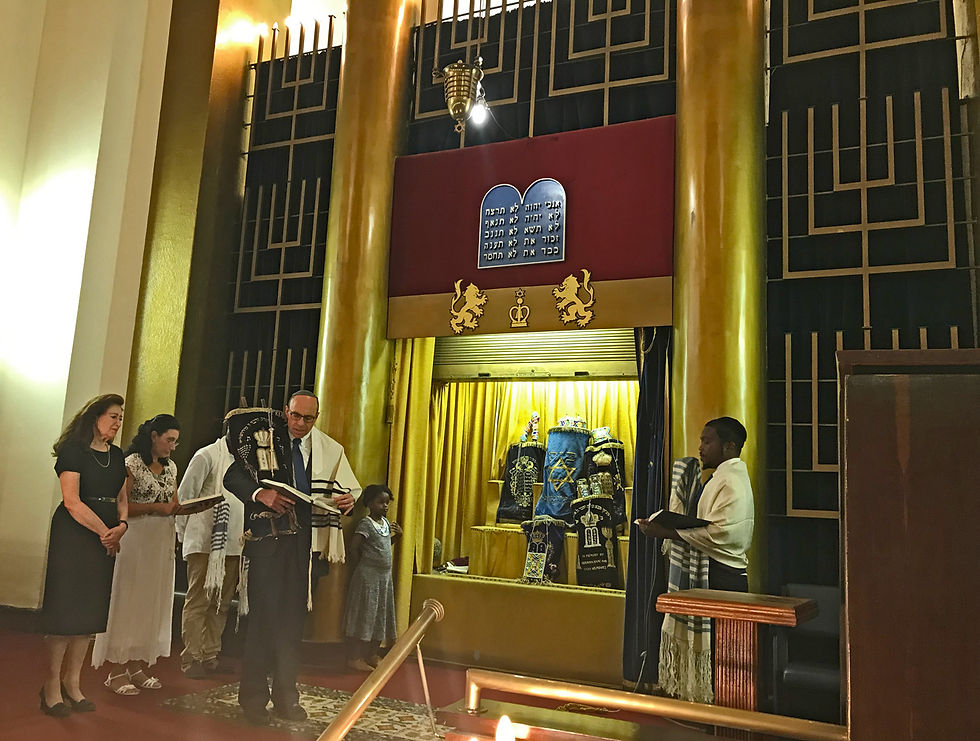
A Saturday service in progress at Temple Israel, led by visiting Rabbi David Benjamin, with Reeva Forman to his left.

Despite being bombed in the early eighties, Temple Israel looks little different today from when it opened in 1936 ... other than the security grills on the front doors.

Seen from the abandoned choir loft, the main sanctuary, hardest hit by the bomb, is much smaller than the original, which in its heyday could seat a thousand people

Temple Israel once loomed over a grassed-over neighbourhood, surrounded by single storey suburban houses

The wood-panelled foyer is covered in plaques, memorials to some who made great contributions, and some who died for noble causes.

Benny Stalson, rabbi in all-but name for decades at Temple Israel, in the courtyard with daughter Lynne and wife Mae. Photograph: Darryl Egnal

Under direction from Reeva Forman, Flo Bird unveils the coveted blue heritage on the front wall, in the presence of Rabbis Sa'ar Shaked and Julia Margolis at right.
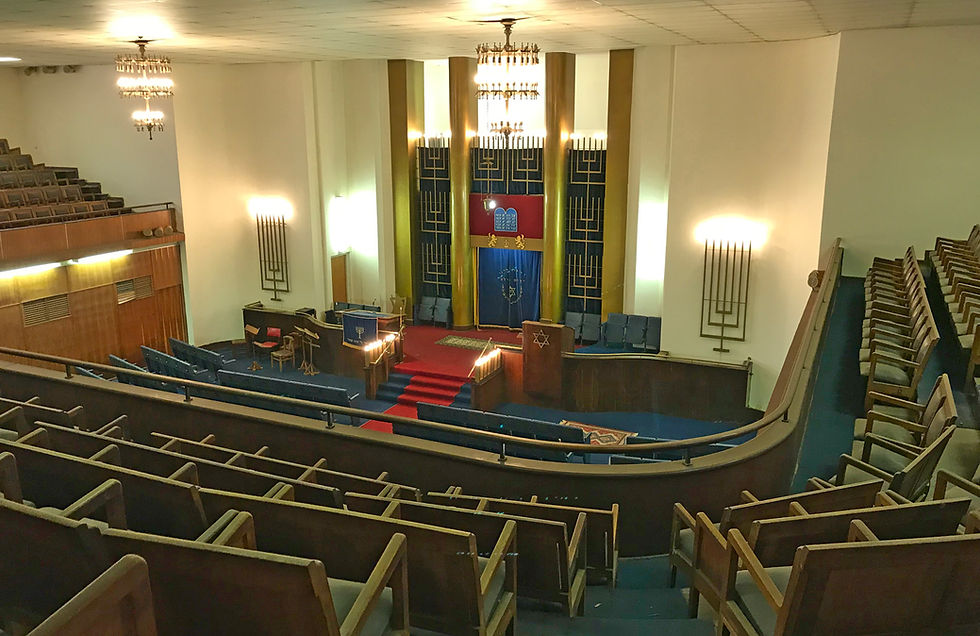
Still beautiful despite 80 years of wear and tear and a bomb attack … the interior of Temple Israel as seen from the upper gallery
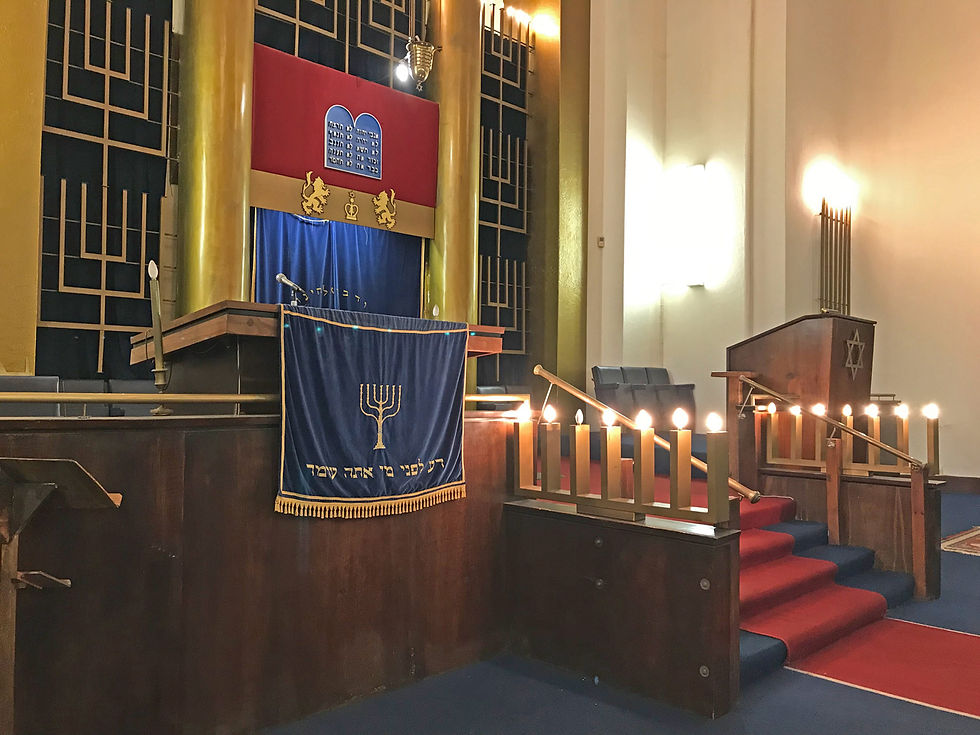
The bimah and ark curtains as seen from the side door
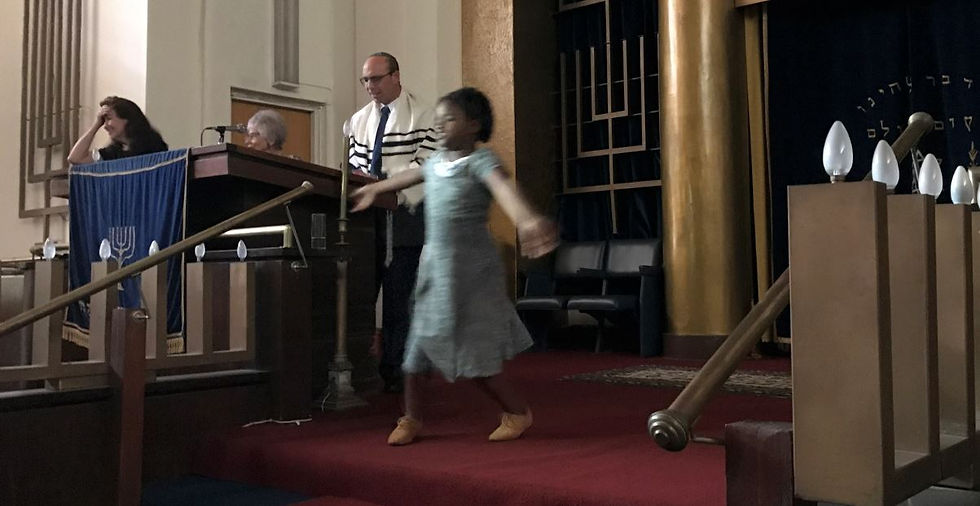
Seven-year-old Angela Moses, who knows the service by heart, is called up to sing the final song, accompanied by her own dance.
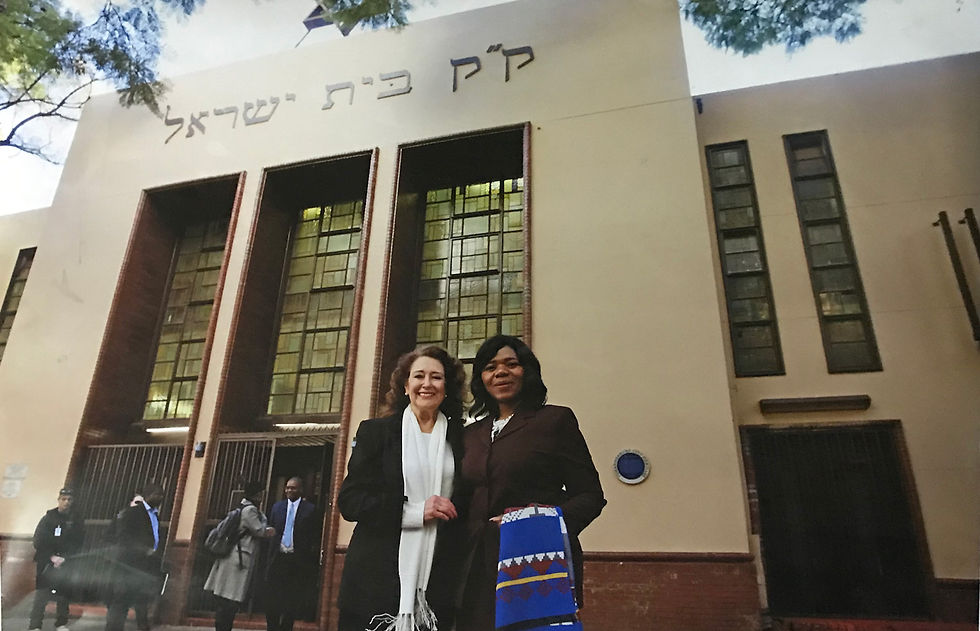
Reeva Forman with Public Protector Thuli Madonsela, who was invited to give a keynote address.

After the service, children gather around the challah to recite the Kiddush blessing before a meal
Notes
[i] Interview with Reeva Forman, 02 January 2019.
[ii] Forman interview, op cit. Judge Margo died seven years later.
[iii] The next-longest serving unbroken chairmanship in Gauteng might be Desmond Sweke’s 12 years at Bet David. Others such as Trevor Egnal at Bet David, Stan Abrahams and Kito Holz at Temple Emanuel, served multiple periods as chairs, but never in a single unbroken stretch.
[iv] Forman interview, op cit.
[v] Leonard Singer interview, 05 July 2014.
[vi] Interview with Darryl Egnal on his 90th birthday, 2007.
[vii] Obituary by Darryl Egnal on his death, 6 February 2011, aged 93. (SAUPJ website).
[viii] There was talk during the sixties of giving him the title of “Reverend”, but this seemed to run into objections from some of the rabbis. Much like Weiler, he also initiated new projects, including the Montagu Sports Club, the Alan Isaacs Camp in Margate and the first youth movement, Matei Sinai.
[ix] A Reform movement retreat for study and recreation, for youngsters and adults, as well as disadvantaged outsiders, founded in 1996 on 65 acres of land donated by the Caplan family, but closed during the financial crises of the eighties. It became the Selwyn Segal Home, and the proceeds of the sale funded the trust, used for Jewish education and rabbinical studies.
[x] Generally considered the architect of modern Reform Zionism, and the one who affiliated the movement to the World Zionist Organisation and moved its headquarters to Jerusalem.
[xi] Rabbi Harris and Bertie Lubner are generally credited as the founders, in 1995. Since then the name has been changed from MaAfrica Tikkun to Afrika Tikkun. Mandela agreed to be Patron-in-Chief in 1999, when he visited a project at Orange Farm, which he described as “a miracle”. (From the organisation’s own history, at https://afrikatikkun.org/about/). The current CEO, since 2006, is Marc Lubner.
[xii] She described how on Shabbat, Rabbi Weiler would come to rest in the family flat, which was close to Temple Israel. Her mother, Ethel Smith, was an innovative leader of the United Sisterhood in the forties and fifties.
[xiii] The nursery school was already catering to the local community, a project initiated by Michael Picardie, an actor and playwright who had initiated several social work programmes across Southern Africa, but had recently left for the UK.
[xiv] Forman interview, op cit.
[xv] Technically, the school was a project of the wider United Sisterhood, rather than of Temple Israel, but in the forties when it was founded, there was only a Temple Israel Sisterhood, and Weiler was indeed the driving force.
[xvi] Left unmentioned was that Kallenbach’s relationship with Temple Israel soured over disputes about payment, changes to the brief and defective workmanship. But it was Weiler who conducted his funeral service in 1945.
[xvii] At the biennial congresses, synagogues are allocated votes by size. But at the regional meetings, which happen very few weeks, each synagogue has one vote.
[xviii] Ronnie Scheurenberg interview, op cit.
[xix] In the 70th Anniversary Brochure of Temple Israel, edited by Darryl Egnal, 2006.